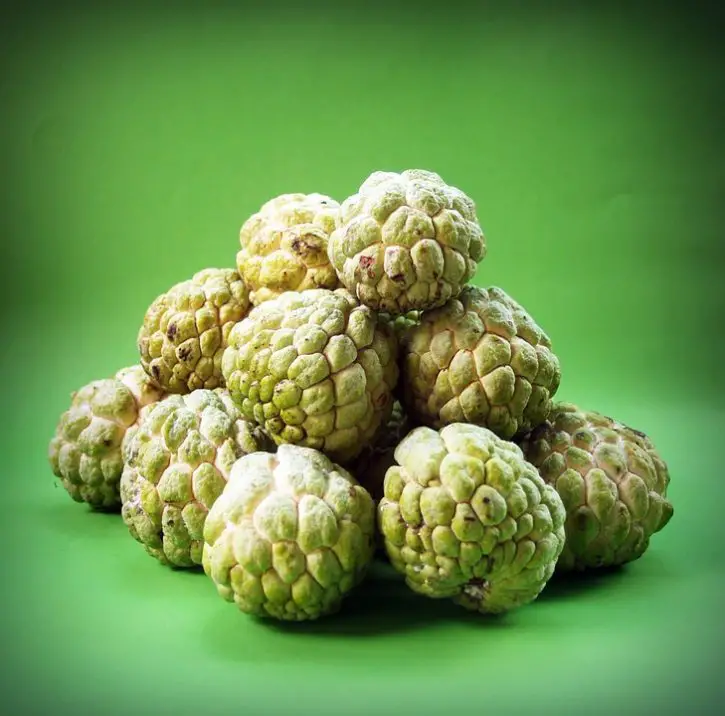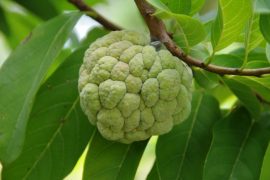Cherimoya Benefits Tree, Seeds and How to Eat
Cherimoya benefits
Cherimoya health benefits. Chirimoya, in English also known as Custard Apples, are native to the Andean highlands of Peru(1, 2). The Chirimoya looks like no other fruit; it’s heart-shaped with rough-textured but thin skin which varies from a yellow-green to a dark green. The inside is white, juicy and fleshy with a creamy custard like texture and dark seeds that look like beans. Chirimoya are sweet and taste like a combination of banana, pineapple, peach and strawberry.
Chirimoya can be peeled and eaten raw or used instead of an apple sauce or cooked apples for crumbles and pies.

1. Cherimoya may help support your digestive system.
Cherimoya possesses a considerable amount of fiber. Fiber stimulates peristaltic motion and increased secretion of gastric juices, which eases digestion, prevents conditions like constipation, and protects the body from more serious conditions like colorectal cancer. One cherimoya contains 7 grams of dietary fiber.
2. Cherimoya may not spike your blood sugar levels.
The glycemic index ranks food and drinks based on their blood sugar increase potential. Foods high on the glycemic index like white rice and white bread will break down easily and cause blood sugar and insulin level spikes after meals, which is followed by rapidly dropping blood sugar levels. Cherimoya is more slowly absorbed into the bloodstream, which could help prevent sugar crashes, sugar cravings, and mood swings.
3. Cherimoya can help maintain a healthy blood pressure.
Cherimoya is loaded with potassium and a low content of sodium. They are well known because of its high potassium content. One cherimoya contains a whopping 839 milligrams of potassium, compared to just 12.5 milligrams of sodium. This helps the blood vessels relax and maintains proper blood pressure.
4. Cherimoya can help your fight infections.
One cup of cherimoya contains 60 percent of the vitamin C daily requirements per cup. Vitamin C is a powerful natural water-soluble antioxidant that helps the body develop resistance against infectious agents and eliminates cancer-causing free radicals in the body.
5. Cherimoya can help improve your heart’s health.
Fiber, vitamin C, and B6, and potassium have been known to improve the heart’s health. The recommended 4,700 mg of potassium is not obtained by many individuals in the United States, according to the National Health and Nutrition Examination Survey, despite the benefits of increased potassium intake. One study suggested that individuals who consumed 4,069 mg of potassium per day had a 49 percent lower risk of death from ischemic heart disease compared with those who consumed less potassium about 1,000 mg per day.
Also, additional fiber has been known to lower “bad” low-density lipoprotein (LDL) cholesterol and increase “good” high-density lipoprotein (HDL) cholesterol in people with type 2 diabetes.
6. Cherimoya can help you sleep better at night.
Cherimoya has been known to help an individual sleep with its high content of magnesium, which is a mineral that is directly linked to improving the quality, duration, and tranquility of sleep. Cherimoya also helps regulate the metabolism, to help reduce sleep disorders and the occurrence of insomnia.
7. Cherimoya may help improve your brain health.
Several components of cherimoya, such as potassium, folate, and various antioxidants are known to provide neurological benefits. Folate has been known to reduce the occurrence of Alzheimer’s disease and cognitive decline. Potassium has been linked to increased blood flow to the brain and enhance cognition, concentration, and neural activity.
Also, cherimoya contains a considerable amount of vitamin B6. A deficiency has shown depression and nausea. Be sure not to consume too much. The vitamin B6 upper limit is set to 100 milligrams for adults over the age of 18, but adults do not need that much unless directed by the doctor.
Cherimoya tree
Common Names: Cherimoya (U.S., Latin America), Custard Apple (U.K. and Commonwealth), Chirimoya, Chirimolla.
Related species: Ilama (Annona diversifolia), Pond Apple (A. glabra), Manrito (A. jahnii). Mountain Soursop (A. montana), Soursop (A. muricata), Soncoya (A. purpurea), Bullock’s Heart (A. reticulata), Sugar Apple (Annona squamosa), Atemoya (A. cherimola X A. squamosa).
Distant affinity: Pawpaw (Asimina triloba), Biriba (Rollinia deliciosa), Wild Sweetsop (R. mucosa), Keppel Apple (Stelechocarpus burakol).
Origin: The cherimoya is believed to be native to the inter-andean valleys of Ecuador, Colombia and Peru. Seeds from Mexico were planted in California (Carpinteria) in 1871.
Adaptation: The cherimoya is subtropical or mild-temperate and will tolerate light frosts. Young growing tips are killed at 29° F and and mature trees are killed or severely injured at 25° F. If cherimoyas do not receive enough chilling, the trees will go dormant slowly and then experience delayed foliation. The amount of chilling needed is estimated to be between 50 and 100 hours. The tree grows well in the coastal and foothill areas of southern California, doing best at a slight elevation, 3 to 15 miles from ocean. It is worth attempting in sunny, south-facing, nearly frost-free locations from San Francisco Bay Area to Lompoc, and may survive to fruit in a very few protected Central Valley foothill locations from Chico to Arvin. Resentful of the excessive dry heat of the interior, it is not for the desert. Cherimoyas are not recommended for container culture.
DESCRIPTION
Growth Habit: The cherimoya is a fairly fairly dense, fast-growing, evergreen tree, briefly deciduous in California from February through April. The tree can reach 30 feet or more, but is fairly easily restrained. Young trees “harp,” forming opposite branches as a natural espalier. These can be trained against a surface, or pruned off to form a regular free-standing trunk. Growth is in one long flush, beginning in April. The roots commence as taproot, but the slow-growing root system is rather weak, superficial, and ungreedy. Young plants need staking.
Foliage: The attractive leaves are single and alternate, 2 to 8 inches long and up to 4 inches wide. They are dark green on top and velvety green on the bottom, with prominent veins. New growth is recurved, like a fiddle-neck. Axillary buds are hidden beneath fleshy leaf petioles.
Flowers: The fragrant flowers are borne solitary or in groups of 2 or 3 on short, hairy stalks along the branches. They appear with new growth flushes, continuing as new growth proceeds and on old wood until midsummer. The flowers are made up of three fleshy, greenish-brown, oblong, downy outer petals and three smaller, pinkish inner petals. They are perfect but dichogamous, lasting approximately two days, and opening in two stages, first as female flowers for approximately 36 hours. and later as male flowers. The flower has a declining receptivity to pollen during the female stage and is unlikely to be pollinated by its own pollen in the male stage.
Cherimoya ripe, How to eat?
Now how do you know when a cherimoya is ready to eat?
First of all it should give in when you slightly squeeze it, like a ripe mango. If it still hard and you could kind of knock on wood with it then it needs a few more days to ripen up.
Another thing to tell if it’s ripe is to take a look at the skin. When the skin is bright and green it’s still unripe. Once it ripens up the skin will get brownish.
Also take a look at the stem. In it’s unripe state the stem is tightly surrounded by the skin and the riper it gets the more it cracks open and sinks in.
Once it’s ripe you can easily pull it apart to open it and eat it almost like an apple (without the skin) or you can scoop out the flesh with a spoon. Just be aware that there are a lot of black seeds in it which are not edible. I think I also read that the seeds are toxic when you crack them open.
Cherimoyas taste like a creamy, custardy pear and they have a soft, juicy white flesh.
They’re rich in water, fibre and contain a lot of vitamin C, iron and potassium which is good for the heart and keeps the blood pressure balanced.
I simply can’t get enough of this fruit!
Cherimoya seeds
Growing the seeds
Plant your seeds immediately when received.
Cherimoya seeds sometimes have trouble kicking off their outer shell, so to help it along, i take a large toenail clipper, and clip off about 1/8 inch (2 mm) at several points around the seed, so that you can partially see inside at several points. It isn’t necessary to clip all the way around. If the edges are too thick to clip, try cracking the seed lightly with a nutcracker. The embryo is well-protected inside and usually doesn’t mind the treatment.
Next, soak the seeds in room temperature water for about 24 hours (not more than 48). Use a well-draining soil mix, such as 2 parts quality potting soil to 1 part perlite or coarse horticultural sand.
Cherimoya seedlings need a tall container, otherwise the taproot can grow deformed, which stunts their growth. Bury them 3/4 inch (2 cm) deep in a deep container (at least 4-5 inches / 10-12 cm tall), and water until the soil is moist (but not soggy). Keep them about 65-77 degrees F (18-25 C). Avoid letting them get above 80° F (27°C) for prolonged periods. I recommend placing a minimum/maximum thermometer near the pots. Give them some air circulation.
They should sprout in about 4-6 weeks. Start them with filtered sun or 1-2 hours of direct sun, but protect from strong afternoon sun. Water as needed to keep the soil moist (but not constantly saturated). Once the seedlings have 3 leaves, gently transplant to a taller pot, and move them into bright shade for a week. You can move them outside if temperatures are mild. Gradually increase the amount of sun they get a little each day, until they have 1/2 day sun after 4-5 months. Cherimoyas prefer partial shade while young.
Remember to protect your plants from frost, especially when young, as they will not survive temperatures under 27-31 degrees F (-2 degrees C).

